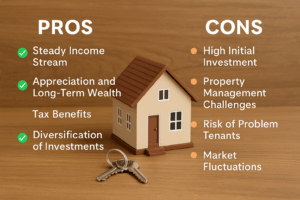If you’re considering buying or selling a home in 2025, one of the most important questions to ask is: “Is it a buyer’s or seller’s market?” Understanding the answer can significantly affect your strategy, timing, and even how much you pay or profit from a real estate transaction.
The real estate market constantly shifts based on supply, demand, interest rates, and regional economic trends. Recognizing whether the current climate favors buyers or sellers can help you make smarter decisions and navigate the process with confidence.
What Is a Buyer’s Market?
A buyer’s market occurs when there are more homes for sale than there are active buyers. This imbalance in supply and demand gives buyers more leverage in negotiations. With a surplus of inventory, homes tend to stay on the market longer. Sellers, facing less competition among buyers, may need to lower their asking prices or offer added incentives to close a deal.
In this type of market, it’s common to see price reductions, generous seller concessions such as covering closing costs or offering home warranties, and more room for negotiation during inspections or contract terms. For buyers, this means more choices, less pressure to make quick decisions, and greater bargaining power.
What Is a Seller’s Market?
Conversely, a seller’s market emerges when buyer demand outpaces available housing inventory. Fewer listings lead to faster sales, often with multiple buyers submitting offers on the same property. Homes may sell above asking price, and sellers find themselves in the driver’s seat when it comes to negotiations.
In these conditions, buyers may feel pressured to waive contingencies, act quickly, or even participate in bidding wars just to secure a home. Sellers, on the other hand, are often able to dictate terms with fewer incentives offered to close the deal. Homes tend to sell faster, sometimes within days of being listed.
How to Tell What Kind of Market You’re In
Several key indicators can help you determine whether you’re in a buyer’s or seller’s market. One of the most widely used metrics is “months of inventory.” This refers to how long it would take to sell all the current listings at the current pace of sales. If there are six or more months of inventory, it’s generally considered a buyer’s market. Three to six months indicates a balanced market, while less than three months points to a seller’s market.
Another valuable data point is the average “days on market.” In a buyer’s market, homes take longer to sell, giving buyers more time to evaluate options. In a seller’s market, properties move quickly often within a week or two.
The sale-to-list price ratio is also telling. When homes consistently sell for more than their asking price, it’s a sign of a competitive, seller-driven environment. In contrast, if properties sell for less than the list price, buyers are likely in control.
Local economic trends and job growth also influence market conditions. Cities experiencing booming employment opportunities or population growth may shift into a seller’s market more quickly, while areas with stagnant growth may lean toward buyers.
How to Navigate Depending on the Market
If you’re a buyer entering a seller’s market, preparation and speed are essential. Getting pre-approved for a mortgage, working with a responsive agent, and being flexible with offer terms can give you a competitive edge. While it’s tempting to make concessions like waiving inspections, it’s important to weigh the risks carefully before removing protections.
For sellers in a buyer’s market, pricing your home competitively is critical. It’s also wise to invest in home staging and professional photography to make your property stand out. Being open to negotiations, including covering closing costs or offering move-in flexibility, can help attract motivated buyers and shorten your home’s time on the market.
Real estate markets can vary widely—not only from year to year but also between cities and even neighborhoods. Understanding whether it’s a buyer’s or seller’s market is key to setting expectations and making informed, strategic choices.
If you’re unsure where your local market stands, consider consulting a trusted real estate professional. With the right insights and guidance, you can better position yourself for success, no matter which side of the transaction you’re on.




